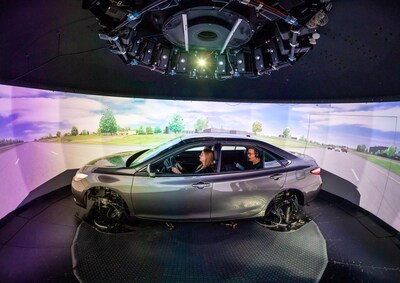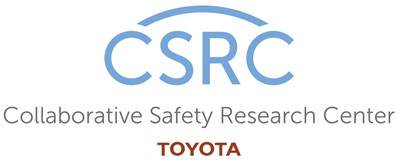Additions to current phase of research explore a diversity of topics in driver behavior, crash avoidance and crash injury mitigation
CSRC, Discovery Education and the University of Massachusetts-Amherst develop new teen driver training program, Risk ATTEND, which launches on TeenDrive365
CSRC also releases summaries of fourteen recently completed projects
ANN ARBOR, Mich., June 4, 2024 /PRNewswire/ -- Toyota's Collaborative Safety Research Center (CSRC) today announced fifteen new projects to help advance automotive safety industrywide for societal good. These additions to CSRC's current five-year research phase focus on better understanding driver behavior, crash avoidance and crash injury mitigation.

"Through launching these projects, CSRC is responding to the latest trends in automotive industry and traffic safety," said CSRC Director Danil Prokhorov. "We are focused on nimbleness by addressing today's safety needs with new insights into future products, processes and policies that can help create a safe mobility society for tomorrow."
Additionally, Toyota announced the launch of the Toyota Risk ATTEND Program (Risk Anticipation Training to Enhance Novice Driving), based on CSRC research. Many new drivers know about distracted driving, but Toyota is extending that knowledge to interactive learning. Through self-paced driving simulation modules developed in collaboration with Discovery Education and the University of Massachusetts-Amherst, teens are exposed to difficult driving scenarios before encountering them behind the wheel, helping to improve drivers' abilities to predict or detect risky situations on the road. The Risk ATTEND module joins the full Toyota teen-driver toolkit at TeenDrive365.
Following are CSRC's new projects, categorized by their application to CSRC's current research tracks – Human-Centric (safe technology interaction with people), Safety Assurance (crash avoidance) and Assessment (safety decision-making empowerment) – which are designed to address the emerging challenges of the changing mobility ecosystem.
Project Title | Collaborator | Research Question | Overview |
Human Centric | |||
Human factors of novel longitudinal vehicle operation | University of Michigan – Dearborn | How can various vehicle speed features (e.g., adaptive cruise, proactive driving assist, BEV one-pedal) be integrated to enhance customer safety and comfort? | Researchers plan to use a combination of psychological tools, driving simulator experiments, and prototype testing to create new design guidance to improve customer experience. |
Customer Education and Onboarding of Driver Assistance Systems | University of Iowa | How can informing drivers of their responsibilities when using driving assistance systems be integrated into various consumer education and onboarding processes to assist safe and efficient use? | Researchers will use driving simulator experiments to test the effectiveness of multiple consumer education approaches delivered at point of purchase, after OTA updates, or real-time use. |
Enabling driver anticipation of L2 driving automation limits | University of Wisconsin | How do different design limitations in SAE L2 driving automation affect drivers' trust and understanding of system functionality? | Researchers will develop a design framework around existing ISO standard methods to provide ways for drivers to anticipate when a safety-relevant event may occur. The focus of this project will be on human-machine interfaces that enable this anticipation. |
Historical analysis of cognitive distraction data | MIT-AgeLab | What are the effects of cognitive distraction in naturalistic (real world) settings? | Leveraging 10+ years of driver distraction research by CSRC and the MIT AgeLab, researchers will explore existing on-road experimental data for new insights into "cognitive" (e.g., non-visual) distraction given the latest scientific perspectives. |
Incorporating driver trip motivations into risky driving prediction and prevention | Touchstone Evaluations, Inc. | Can driver trip goals and types be used to predict and prevent risky driving behaviors? | Researchers will analyze naturalistic (real world) driving data to classify trip goals and types and incorporate these into new prediction algorithms to assist in risky driving prevention countermeasures. |
Driver state management through behavioral safety interventions | Touchstone Evaluations, Inc. | Can a driver's negative behaviors or conditions be reduced through behavioral interventions? | Researchers will conduct two studies evaluating ways to reduce combinations of negative driver conditions, such as stress or distraction, to guide development of driver messages and feedback to enhance the driver experience and safe decision-making. |
Safety Assurance | |||
High Speed Crash Scenarios and Effectiveness of Automatic Emergency Braking (AEB) | University of Michigan Transportation Research Institute (UMTRI) | How effective are current automatic emergency braking (AEB) systems for typical high-speed crashes in the US, and how could they be further enhanced? | Researchers will use in-depth analysis of high-speed crash data from existing US databases to estimate the real-world performance of AEB systems to guide future system design and assessment tests. |
Vulnerable Road Users (VRU) Trajectory Prediction | Purdue University Indiana University | Can the sudden movements of pedestrians, cyclists, and other VRUs be predicted in advance? | Using previously collected real-world data, researchers will use machine learning to create trajectory prediction algorithms from camera, lidar, radar, G sensor, and high-definition maps to provide tools for enhancing future crash avoidance technology. |
Micro Doppler Signatures for Vulnerable Road Users (VRU) | Purdue University Indiana University
| Can the latest sensor strategies enhance vehicle detection of pedestrians, cyclists, and e-scooter riders? | Researchers will take more than 500 Micro Doppler (MD) measurements of 30 different VRUs at several distances and motion directions and use these to study VRU recognition methods considering potential test surrogates. |
Characterizing Crashes Related to Driver Alcohol Impairment | Impact Research, LLC | What driver and travel scenarios are most associated with alcohol-related crashes and fatalities? | Researchers will study the latest data from US crash databases and police crash reports to quantify trends for drivers and trip types as well as the potential effects of the latest crash avoidance technology. |
Assessment | |||
Ankle injury assessment considering human diversity | University of Virginia & Michigan Medicine | How can we use test dummies to predict differences in injury risk among the diverse driver population? | Leveraging the Total Human Model for Safety (THUMS) and a new tool developed with a previous CSRC project, collaborators will simulate hundreds of combinations of body shape and crash characteristics, matching these same conditions with virtual dummies to guide new safety assessment tests. |
Injury prediction in side impact virtual assessments | University of Virginia | How can digital humans be used for safety assessments in side impact crash scenarios? | Research collaborators will develop relationships between measures of deformation in human models such as Toyota's Total Human Model for Safety (THUMS) to standardize a process for predicting rib fractures in near- and far-side impacts for potential virtual assessments. |
Predicting whiplash injury using parametric digital humans | University of Michigan Transportation Research Institute (UMTRI) | How can digital humans be used to consider effects of population diversity in rear impact crash injury? | Leveraging previous CSRC efforts on parametric human body models, researchers will use clinical imaging to understand neck anatomic variation and update Toyota's Total Human Model for Safety (THUMS) to guide future safety innovations and virtual assessments for diverse populations. |
Lumbar spine Injury prediction with crash test dummies | University of Virginia | How can future crash test tools be enhanced to better assess lumbar spine injury in crashes? | Leveraging previous CSRC efforts to understand the lumbar spine biomechanics, researchers will use digital simulations of humans and dummies at the component level and in simulated crash conditions to develop and validate a new lumbar spine injury prediction measure for use in future crash assessments. |
Anthropometry of pregnant drivers for future crash safety assessment | University of British Columbia | How do expectant mothers position themselves while driving? | Researchers will collect detailed 3D body shape and posture data from approximately 500 pregnant females with automotive seats and seat belts to understand potential areas for future safety innovations |
Further, CSRC released summaries of fourteen recently completed projects, which are available for download and review HERE.
Toyota created CSRC in 2011 to advance safety for the industry as a whole through open collaborations with universities, hospitals and other research institutions. Results are published and openly presented for others to utilize and benefit from the research.
With these new initiatives, CSRC now has completed or commenced 116 research projects with more than 30 different institutions. CSRC results are regularly published in prestigious scientific journals and presented at world-renowned conferences, meetings, and directly with key stakeholders. Through these outreach efforts, the projects have made meaningful contributions to help advance research and technology relating to the safe integration of future mobility solutions for all.
About Toyota
Toyota (NYSE:TM) has been a part of the cultural fabric in North America for more than 65 years, and is committed to advancing sustainable, next-generation mobility through our Toyota and Lexus brands, plus our more than 1,800 dealerships.
Toyota directly employs more than 63,000 people in North America who have contributed to the design, engineering, and assembly of nearly 47 million cars and trucks at our 12 manufacturing plants. By 2025, Toyota's 13th plant in North Carolina will begin to manufacture automotive batteries for electrified vehicles. With more electrified vehicles on the road than any other automaker, Toyota currently offers 29 electrified options.
For more information about Toyota, visit www.ToyotaNewsroom.com.
About TMNA R&D
For more than 50 years, Toyota Motor North America Research & Development (TMNA R&D) has led engineering for several of the best-selling Toyota vehicles on U.S. roads. Teams are now creating both next-generation vehicles and new and advanced mobility concepts that can better move people, goods and information. Toyota's innovation has produced more patents from the United States Patent and Trademark Office than any other automaker for the past 10 consecutive years (2,667 in 2023). Centered in Ann Arbor, Michigan, TMNA R&D is pursuing Toyota's mission to "Produce Happiness for All" by making life safer, easier and more enjoyable. Globally, Toyota spends approximately $1 million per hour on R&D to ensure that Toyota rapidly and continuously develops cutting-edge, high-quality, and appealing vehicles.
MEDIA CONTACTS
Rick Bourgoise
richard.bourgoise@toyota.com
Olivia Boisineau-Beckett
olivia.boisineau-beckett@toyota.com

![]() View original content to download multimedia:https://www.prnewswire.com/news-releases/toyotas-collaborative-safety-research-center-announces-fifteen-new-research-projects-to-advance-safety-for-the-automotive-industry-302163550.html
View original content to download multimedia:https://www.prnewswire.com/news-releases/toyotas-collaborative-safety-research-center-announces-fifteen-new-research-projects-to-advance-safety-for-the-automotive-industry-302163550.html
SOURCE Toyota Motor North America



